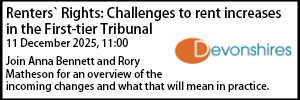The importance of an appropriate Mortgagee Exclusion Clause
- Details
Claire Waring considers the use of a Mortgagee Exclusion Clause (MEC) and explains why careful drafting is key.
What is a MEC?
A MEC is the name given to the provisions of a section 106 agreement which, in the event of loan default by the RP (registered provider), allows an RP’s lender to sell the affordable housing dwellings free of the affordable housing restrictions contained in the section 106 agreement.
Types of MEC
There are generally two types of MEC:
- The first type is an absolute MEC that does not impose any controls on the lender or prescribe any process which must be followed before the lender can sell the properties on an unfettered basis.
- The second type is a conditional MEC which prescribes a process which must be followed before the lender is able to sell on an unfettered basis. Essentially, the lender must first try to sell the properties to another RP or local authority in order to keep them within the affordable housing sector. In order to be acceptable to a lender the conditional MEC should provide for the sale to another RP or local authority to be completed within a period of no more than three months and at a price that allows them to fully redeem the mortgage, including associated interest and costs. If the lender is unable to sell to another RP or local authority within this time-frame then the lender should be able to sell to anyone free of the affordable housing restrictions which then automatically fall away.
RPs are more likely to get local authorities to agree a conditional rather than absolute MEC.
Why is an MEC important?
When an RP is charging properties as security for debt, it will want to achieve the highest possible valuation for the stock.
The absence of a MEC or a MEC which is not in a form acceptable to a lender can make the difference in securing tens of millions of pounds more value.
To get the maximum value the lender must be able to sell the tenanted property on the open market free from any restrictions if the RP has defaulted on its loan.
If there are restrictions in place which mean that a lender is only able to sell the properties for use as affordable housing, then they will only allow the RP to borrow against those properties at Existing Use Value for Social Housing (EUV-SH), which is the value given to properties that must be retained in the affordable housing sector.
If there are no such restrictions in place so that the lender is able to sell on an unfettered basis, then they will allow the RP to borrow against those properties at Market Value Subject to Tenancies (MV-STT) which is significantly more than EUV-SH.
Consequently, having a MEC in a form acceptable to a lender is fundamental in achieving the maximum value when charging properties.
The devil is in the detail!
As stated above, as things currently stand, in order to be acceptable to a lender the conditional MEC should provide for the sale to another RP or local authority to be completed within a period of no more than three months and at a price that allows them to fully redeem the mortgage, including associated interest and costs. If the lender is unable to sell to another RP or local authority within this time-frame then the lender should be able to sell to anyone free of the affordable housing restrictions which then automatically fall away.
The above requirements for an ideal MEC have not always been the case and what was once acceptable is no longer. It is not unusual to see stock that was successfully charged 15 to 20 years ago now presenting a challenge on refinancing as the MEC is no longer acceptable. It is possible to try to address such issues by entering into a deed of variation to update the MEC to an acceptable form. However, there is no guarantee that a local authority will agree to a deed of variation. It is a case of trying persuade them by explaining the need and rationale.
The best form of MEC to use is that agreed by the Property Finance Working Group as that is known to be currently acceptable to lenders. However, many local authorities want to use a different form of MEC. In that situation, great care should be taken as even what appear to be very minor variations can render a MEC unacceptable to lenders. In such situations, we are happy to review the proposed alternative MEC to ensure that it will allow charging at MV-STT.
Claire Waring is a partner at Wright Hassall.
Must read
Fix it fast: How “Awaab’s Law” is forcing action in social housing
Housing management in practice: six challenges shaping the sector
Why AI must power the next wave of Social Housing delivery
Sponsored articles
Walker Morris supports Tower Hamlets Council in first known Remediation Contribution Order application issued by local authority
Unlocking legal talent
09-12-2025 1:00 pm
11-12-2025 11:00 am







































